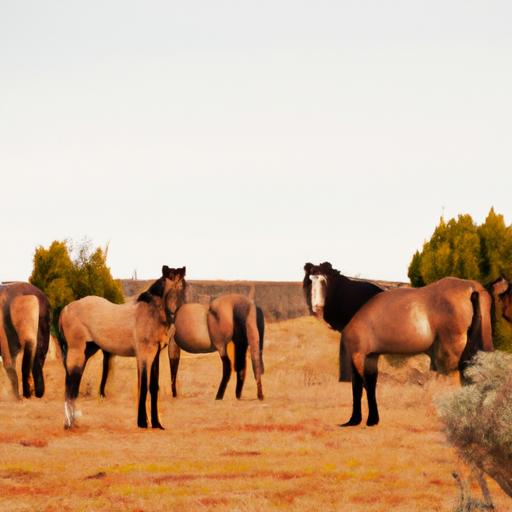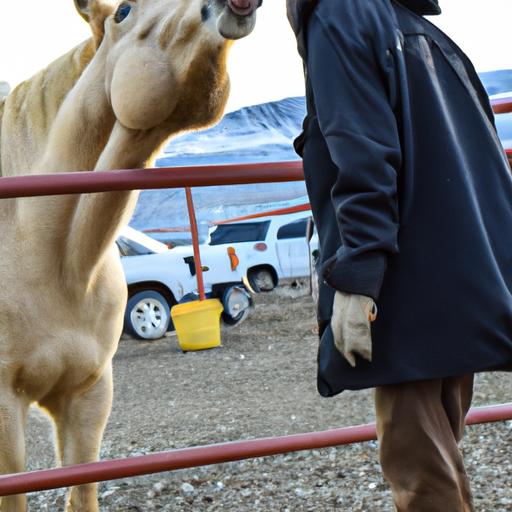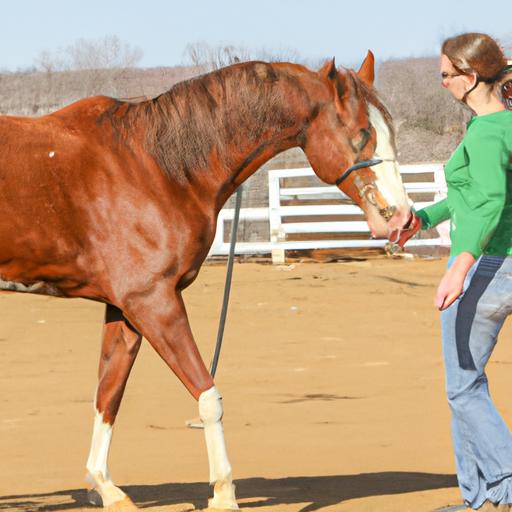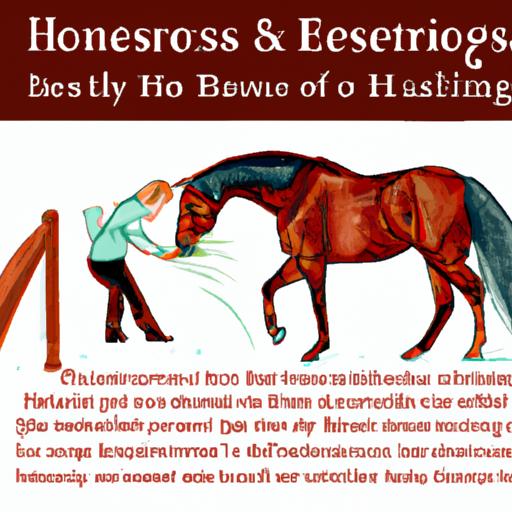Uncover the fascinating world of horse behavior science and its impact on equine care and training. Enhance your understanding of your equine partner. Horse Behavior Science: Unlocking the Secrets.
Introduction

As equestrians, we share an unspoken bond with our horses. Yet, have you ever wondered what truly drives their behavior? What if I told you there is a fascinating field dedicated to unraveling the mysteries of horse behavior? Welcome to the realm of horse behavior science!
A. Definition and importance of horse behavior science
Horse behavior science is the study of how horses think, communicate, and interact with their environment. It delves into the innate instincts, social dynamics, and psychological responses that shape their behavior. By understanding the science behind equine behavior, we can effectively train, care for, and connect with our equine companions.
B. Overview of the role of horse behavior science in horse care and training
Horse behavior science plays a pivotal role in every aspect of horse care and training. It provides valuable insights into how horses learn, perceive their surroundings, and respond to various stimulBy embracing this knowledge, we can create training programs that are not only effective but also considerate of the horse’s mental and emotional well-being.
Imagine having the ability to decipher your horse’s body language, decode their subtle cues, and address behavioral issues with confidence. With horse behavior science as our guide, we can enhance the training process, build trust-based relationships, and ensure the overall welfare of our equine partners.
So, join me on this captivating journey of exploration into the depths of horse behavior science. Let’s unravel the secrets that lie behind those gentle eyes and discover a profound understanding of our incredible equine companions.
Stay tuned for the next section, where we’ll delve into the rich history of horse behavior science.
Unveiling the Journey of Horse Behavior Science

Early Studies and Observations
The quest to understand the intricate world of horse behavior dates back centuries. Ancient civilizations, such as the Greeks and Romans, marveled at the majestic equine creatures and made observations about their social dynamics and individual behaviors. However, it wasn’t until the 18th and 19th centuries that systematic studies on horse behavior began to take shape.
Pioneering equestrians and scientists like François Robichon de La Guérinière and Gustav Rau delved into the realms of equine behavior, recognizing the significance of understanding horses’ natural instincts and social behaviors. Their observations laid the foundation for future research and set the stage for the emergence of horse behavior science as a distinct discipline.
Milestones in the Development of Horse Behavior Science
The 20th century witnessed significant milestones in the field of horse behavior science, paving the way for a deeper understanding of our equine companions. Notably, the groundbreaking work of Konrad Lorenz and his studies on animal behavior, including horses, revolutionized the field. Lorenz’s insights into ethology, the study of animal behavior in their natural habitats, provided valuable frameworks for comprehending horse behavior.
Moreover, the advent of technology, such as high-speed cameras and advanced tracking systems, enabled researchers to capture and analyze equine behavior with unprecedented precision. This technological progress has further expanded our knowledge of horse behavior, shedding light on their movements, social interactions, and cognitive abilities.
Contributions of Notable Researchers in the Field
Throughout history, numerous researchers have contributed significantly to the field of horse behavior science, enriching our understanding of equine behavior. Notably, Dr. Robert M. Miller, Dr. Temple Grandin, and Dr. Andrew McLean have made substantial contributions through their research and practical applications.
Dr. Miller’s work on imprint training and understanding equine learning processes has transformed the way we approach horse training. Dr. Grandin’s insights into animal welfare have led to the development of more humane handling and facility designs, benefiting horses and other animals alike. Dr. McLean’s research on equine learning theory and cognitive abilities has provided valuable tools for enhancing training techniques and promoting positive equine-human interactions.
Their collective efforts, along with countless other researchers, have shaped the landscape of horse behavior science and continue to propel the field forward. Through their dedication, we gain deeper insights into the workings of the equine mind, fostering a harmonious partnership between humans and horses.
Stay tuned for the next section, where we’ll explore the fascinating world of horse behavior and the natural instincts that drive them.
Understanding Horse Behavior

Horses, magnificent creatures that they are, possess a complex array of behaviors and instincts. To truly comprehend their behavior, we must delve into their intrinsic nature and observe how they interact with their environment. Let’s explore the fascinating world of horse behavior together.
A. Natural instincts and behaviors of wild horses
In the vast open plains, wild horses roam freely, guided by their instinctual behaviors honed over thousands of years. These instincts are rooted in their survival mechanisms and social dynamics. Wild horses form cohesive herds, relying on strength in numbers to protect themselves from predators. They exhibit behaviors such as grazing, social grooming, and engaging in playful interactions, which strengthen the bonds within the herd.
B. Domestication and its impact on horse behavior
The process of domestication has significantly influenced the behavior of horses. Over time, humans selectively bred horses for specific traits, altering their natural instincts and instincts to better suit our needs. This transformation has led to variations in behavior across different breeds. For instance, some breeds may display higher levels of energy and athleticism, while others may exhibit a calmer temperament.
Additionally, the domestication process has introduced horses to novel environments, such as stables and arenas. These artificial settings can impact their behavior, as they need to adapt to confinement, socialization with humans, and exposure to various stimul
C. Communication methods and body language of horses
Horses possess a nuanced language of their own, primarily communicated through body language and subtle cues. They use their ears, tail, and posture to convey messages to other horses and humans. Understanding their communication methods allows us to interpret their intentions, emotions, and level of comfort in different situations.
By observing their body language, we can discern signs of relaxation, tension, fear, or trust. For example, a relaxed horse may have a lowered head, soft eyes, and loose muscles, indicating contentment. Conversely, a tense horse may exhibit a raised head, wide eyes, and tightly held muscles, signifying anxiety or stress.
By delving into the intricacies of horse behavior, we gain profound insights into their instinctual nature, the impact of domestication, and the language they use to communicate. Armed with this understanding, we can develop a deeper connection with our equine partners and build a solid foundation for effective training and care.
Stay tuned for the next section, where we’ll explore the practical applications of horse behavior science in training.
Applications of Horse Behavior Science in Training
A. Positive Reinforcement Methods
When it comes to training our equine companions, positive reinforcement techniques have emerged as powerful tools rooted in horse behavior science. By rewarding desired behaviors, we can motivate horses to willingly engage in learning and develop a positive association with training sessions.
Gone are the days of dominance-based training methods that relied on force and coercion. Instead, we can harness the power of positive reinforcement by using treats, praise, and clicker training to reinforce behaviors we wish to encourage. This approach not only fosters a harmonious partnership but also promotes a horse’s willingness to learn and participate.
B. Understanding and Addressing Behavioral Issues
Horse behavior science equips us with a deeper understanding of the underlying causes of behavioral issues that horses may exhibit. Whether it’s anxiety, fear, or aggression, these behaviors often stem from a horse’s natural instincts or past experiences. By comprehending the root causes, we can tailor our training approaches to address and alleviate these issues.
Through observation and analysis, we can identify triggers that elicit undesirable behaviors and implement strategies to modify them. With the knowledge gained from horse behavior science, we can gradually desensitize horses to these triggers, modify their responses, and ultimately improve their overall behavior and emotional well-being.
C. Incorporating Horse Behavior Science into Training Programs
To truly optimize our training programs, it is essential to integrate horse behavior science principles. By doing so, we can create individualized training plans that consider a horse’s natural instincts, learning style, and unique personality traits. This tailored approach enhances the effectiveness of the training process, leading to better outcomes and a stronger bond between horse and handler.
Incorporating horse behavior science into training programs involves utilizing techniques such as operant conditioning, positive reinforcement, and understanding the horse’s body language. By adapting our methods to align with the horse’s innate behaviors and communication style, we can create a positive and productive training environment.
By harnessing the power of positive reinforcement, addressing behavioral issues with empathy and understanding, and incorporating horse behavior science into our training programs, we can unlock the true potential of our equine partners. Stay tuned for the upcoming section, where we’ll explore the impact of horse behavior science on equine welfare.
Horse Behavior Science and Equine Welfare
A. Ethical considerations in horse training and handling
When it comes to horse training and handling, ethical considerations are paramount. Horse behavior science provides us with invaluable tools to ensure that our practices are rooted in compassion, understanding, and respect for these magnificent creatures. By delving into the science behind equine behavior, we can make informed decisions that prioritize the well-being of our horses.
Gone are the days of dominance-based training techniques that relied on fear and force. With a deep understanding of horse behavior, we can embrace positive reinforcement methods that foster trust, cooperation, and mutual respect. By rewarding desired behaviors rather than punishing unwanted ones, we create an environment where horses thrive and willingly engage in the training process.
B. Promoting the well-being of horses through behavior science
The well-being of horses should always be at the forefront of our minds. Horse behavior science equips us with the knowledge to recognize signs of stress, discomfort, or anxiety in our equine partners. By understanding their natural instincts, social needs, and preferences, we can provide an environment that supports their physical, mental, and emotional well-being.
Behavior science allows us to tailor husbandry practices to meet the individual needs of each horse. From designing turnout spaces that encourage natural movement and social interaction to implementing feeding routines that mimic their grazing behavior, we can create a lifestyle that promotes their overall health and happiness.
C. The impact of horse behavior science on improving horse-human relationships
The intricate dance between a horse and its handler is a testament to the power of a strong bond. Horse behavior science serves as a bridge, deepening the connection between humans and horses. By understanding their communication methods, body language, and social dynamics, we can better interpret their needs and respond appropriately.
When we approach our interactions with horses through the lens of behavior science, we foster a relationship built on trust, clear communication, and mutual understanding. This not only enhances the training process but also strengthens the bond we share with these majestic animals. Through behavior science, we unlock the potential for harmonious partnerships and a deeper appreciation of the horse-human relationship.
Stay tuned for the upcoming section, where we’ll explore the future of horse behavior science and the exciting possibilities that lie ahead.


